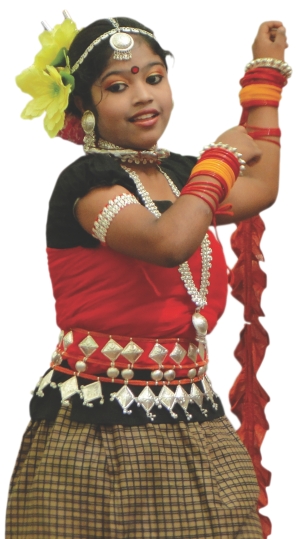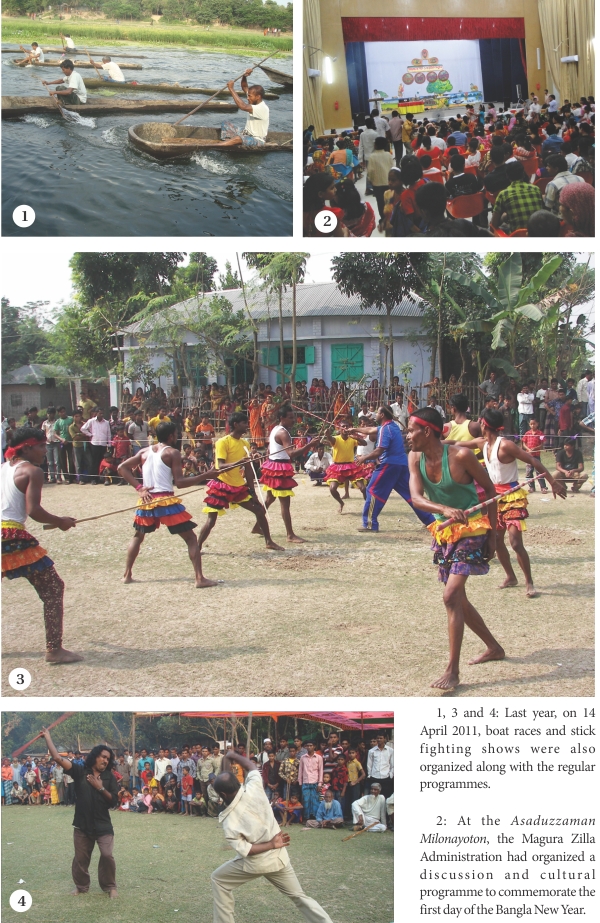|
Cover Story
Starting 1419 at Magura
The first day of the Bangla year has become the second most widely celebrated festival in Bangladesh. And this is true not just in Dhaka. In Magura, for example, the townsfolk shop in preparation for the event and wake up early on the day to greet their friends and neighbours in their best attire! Rallies and the beat of drums shake the otherwise quiet town early in the morning at 6.30am; and the scores of culturally active people throng the Public Library to organize day-long song and dance fests. Amid the colours, the painted faces, the food and the merriment, one finds it difficult to stay downbeat!
...............................................................................................................
Zahidul Naim Zakaria

I woke with the sound of drums. It was a steady beat that drew closer, as did the sound of an approaching crowd. A second beat joined the rhythm, raising the tempo as I got out of bed to look out the window of my room at Hotel Chourongi. It hadn't been fifteen minutes after sunrise, and already people dressed in red and white were out in the streets, congregating at Chourongi intersection of Magura. I washed up in a jiffy and changed my clothes, and was out of the hotel with my camera in my hand as soon as I could.
After Eid, Pohela Boishakh has become the next most anticipated national event in Bangladesh. And people now prepare for the day with tremendous excitement. The Magura town, a small place within the Khulna division about 200 kms from the capital city, is full of people who are culturally very active. School teachers, lawyers, writers and poets are also singers and dancers, and there are numerous cultural clubs in Magura. The rallies went on for hours as people in bright colours circled the city, holding up masks and props. Townsfolk either dressed in red and white Sarees and Panjabis, or they were dressed in traditional costumes. One group decided to be different, wearing the colours of the flag. Some fashioned themselves as farmers and cattlemen or as brides and grooms. There were even a few dressed as trees who fondly followed the farmers around!
 Five cultural clubs jointly organized a day long cultural programme at the Syed Ator Ali Public Library, next to the Primary School. With a diverse mix of music, songs, dance and poetry recitation, the cultural programme grounds were full of people all day long. As the programme went on, to the right of the stage, a small crowd of youngsters around ages of 5 to 8 started to cluster around an elderly man with a paintbrush. His adept hands dipped the thin brush into red, white and green colours as he drew patterns and the number 1419 on the faces of the children, all of them leaving the crowd happier than they had joined – their faces as illuminated as their spirits. Five cultural clubs jointly organized a day long cultural programme at the Syed Ator Ali Public Library, next to the Primary School. With a diverse mix of music, songs, dance and poetry recitation, the cultural programme grounds were full of people all day long. As the programme went on, to the right of the stage, a small crowd of youngsters around ages of 5 to 8 started to cluster around an elderly man with a paintbrush. His adept hands dipped the thin brush into red, white and green colours as he drew patterns and the number 1419 on the faces of the children, all of them leaving the crowd happier than they had joined – their faces as illuminated as their spirits.
The afternoon heat dialed things down a bit, just a tad bit. The familiar faces of people on the side of the streets occupying the tea stalls remained, albeit in the shades. The evening, however, showed me a completely different side of the city of Magura. I had thought the morning crowd was a good turnout. Little did I know, as the sun tipped over the midday line, and as the heat dropped slowly, hundreds of people would start to take to the streets? Magura bore the face of a busy Dhaka city intersection, with city traffic slowing down. Whereas the morning crowd drew families, the streets in the evening were full of youngsters and teenagers out looking for a fun time on a national holiday.
The one thing that I was still waiting to see was a fair. And my thirst would not go unquenched. Although there was no organized fair, at dusk, hundreds of people had gathered at the field in front of Asaduzzaman Milonayoton, and it was no less than a fair. There were food carts, balloons and yo-yo's that lit up with motion. Inside the auditorium, the Magura Zilla Administration had organized a discussion and cultural programme to commemorate the first day of the Bangla New Year.
Although I had a lot of fun starting 1419 at Magura with the Daily Star's Magura Correspondent Hossain Seraj, I did not get to see two interesting attractions that people of Magura organize every year on Pohela Boishakh. Usually Magura's celebration of Pohela Boishakh is much larger than this year's one. Last year, boat races and stick fighting shows were also organized along with the regular programmes, as we can see in the snaps from last year on the next page.

Historically, under the Mughals, agricultural taxes were collected according to the Hijri calendar. Since the Hijri calendar is purely a lunar calendar, and since its beginning does not coincide with the harvest, farmers had to pay taxes before they had started to earn money by selling their crops. This problem was solved over fourteen hundred years ago, when the Mughal Emperor Akbar ordered the formation of a new calendar that would start with the crop harvest season. Accordingly, Fatehullah Shirazi, a renowned scholar and astronomer, formulated the Bengali year, and the new Fasli San (agricultural year) was introduced in 1584 AD. But the year was dated from Akbar's ascension to the throne in 1556, meaning the first time the Bangla New Year had been celebrated, it was in its 28th year.
Celebrations of Pohela Boishakh had started from Akbar's reign. It was customary to clear up all dues on the last day of the year and exchange sweets. Over centuries, taxes and their collection have become guided by more modern policies. I guess not many businesses start new book of accounts on 14 April anymore. But, the traditions of the Bangla New Year have remained. Alive is the merriment, the colours, the rallies, the songs, the dances. Alive is the hospitality of the people of Bengal.
Photographs by Hossain Seraj and Zahidul Naim Zakaria

Copyright
(R) thedailystar.net 2012 |



 Five cultural clubs jointly organized a day long cultural programme at the Syed Ator Ali Public Library, next to the Primary School. With a diverse mix of music, songs, dance and poetry recitation, the cultural programme grounds were full of people all day long. As the programme went on, to the right of the stage, a small crowd of youngsters around ages of 5 to 8 started to cluster around an elderly man with a paintbrush. His adept hands dipped the thin brush into red, white and green colours as he drew patterns and the number 1419 on the faces of the children, all of them leaving the crowd happier than they had joined – their faces as illuminated as their spirits.
Five cultural clubs jointly organized a day long cultural programme at the Syed Ator Ali Public Library, next to the Primary School. With a diverse mix of music, songs, dance and poetry recitation, the cultural programme grounds were full of people all day long. As the programme went on, to the right of the stage, a small crowd of youngsters around ages of 5 to 8 started to cluster around an elderly man with a paintbrush. His adept hands dipped the thin brush into red, white and green colours as he drew patterns and the number 1419 on the faces of the children, all of them leaving the crowd happier than they had joined – their faces as illuminated as their spirits.
